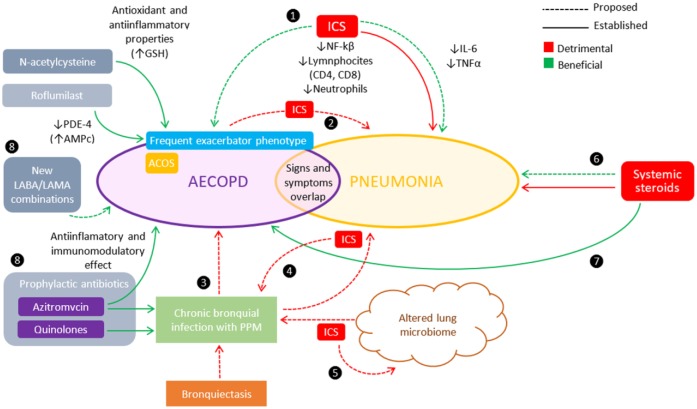Figure 1.
Complexity and heterogeneity of the inflammatory response in acute exacerbation of chronic obstructive pulmonary disease (AECOPD) and pneumonia and possible impact of inhaled corticosteroids (ICS).
❶ There is a paradoxical double effect of ICS consisting of increased episodes of pneumonia despite their protective effect on exacerbations. ICS-induced pneumonia events have shown unmodified or even lower mortality rates, perhaps by modulating effect on the local anti-inflammatory response after pneumonia onset. The inhibition of nuclear factor kappa B (NF-ƙB) [Singanayagam et al. 2010], lower neutrophil and lymphocyte counts [Jen et al. 2012], and a reduced systemic inflammatory response (lower interleukin (IL)-6 and tumor necrosis factor (TNF)-α levels] [Ferrer et al. 2014] have been implicated. ❷ Many pneumonia events associated with the use of fluticasone propionate (FP) are preceded by an AECOPD [Calverley et al. 2011]. ❸ The presence of chronic bacterial colonization of the airways has been implicated is the frequency and severity of AECOPD [Patel et al. 2002], particularly in patients with bronchiectasis [Patel et al. 2004]. ❹ ICS are known to increase bacterial load in stable COPD [Garcha et al. 2012], but the role of these changes in the development of an AECOPD is uncertain [Sethi et al. 2007]. ❺ COPD patients have alterations in their lung microbiome that may result in chronic infection with potentially pathogenic microorganisms (PPM) [Miravitlles and Anzueto, 2015], and the use of ICS may further alter this microbiome [Pragman et al. 2012; Huang et al. 2014]. ❻ Chronic use of systemic steroids is a known risk factor for pneumonia [Wolfe et al. 2006]. Nevertheless, some studies have shown benefits when treating pneumonia with systemic corticosteroids to mitigate the immune response [Torres et al. 2015; Tagami et al. 2015; Blum, 2015]. ❼ The role of systemic steroids in the treatment of AECOPD is well established [GOLD, 2015]. ❽ Alternatives to ICS for the prevention of AECOPD include mycolitics, PDE-4 inhibitors such as roflumilast, and prophylactic antibiotics [GOLD, 2015; Criner et al. 2015]. There is also a potential role the new LABA/LAMA combinations (see the text).

